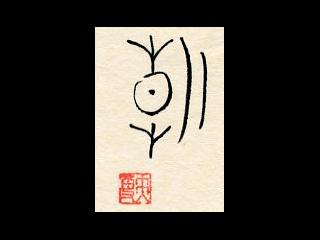【潮】 Chou The Character for Tide
|
I shall introduce an easily approachable character from nature here. Originally, 'tide' was a character combining 水 'water,' 艸 'grass' and 日 'sun' only; the 'moon' was added later. Above and below the sun are the pictograms for grass. There are also forms for this character with inverse sides. The moon was added for the first time in the Tenbun (Zhuan Wen) seal script.
In antiquity, the characters for celestial bodies such as the sun and the moon had a dot in the middle (there are exceptions), which we can see in 日 (sun, day). The dot also distinguishes ○ 'gem' (of 環) from 日, which would otherwise have been written the same. (In poetic language, the sun, moon and stars were often compared to gems. This is also the case in the Zhuang Zi).
In ancient Chinese characters (carved on tortoise plastron and oracle bones and bronze vessels), the character for 'moon' does not appear. This, of course, does not mean that people then were not interested in the moon. Probably, there was not yet an understanding of the moon's relation to the earth's gravity and tides.
The special thought and attention in Japan to the moon can be understood and is seen in Heian literature like the 'Hyakuninisshu: The Hundred Poems by One Hundred Poets.' Inclination to the moon in ancient China also is conspicuous. The character 望 engraved on bronze vessels shows that a month was divided into four weeks. Although there was no scientific discovery of gravity, this character shows not only the inclination to the moon, but also bears a relation to calm astronomical observation of the atmosphere and the clouds.
In antiquity, the characters for celestial bodies such as the sun and the moon had a dot in the middle (there are exceptions), which we can see in 日 (sun, day). The dot also distinguishes ○ 'gem' (of 環) from 日, which would otherwise have been written the same. (In poetic language, the sun, moon and stars were often compared to gems. This is also the case in the Zhuang Zi).
In ancient Chinese characters (carved on tortoise plastron and oracle bones and bronze vessels), the character for 'moon' does not appear. This, of course, does not mean that people then were not interested in the moon. Probably, there was not yet an understanding of the moon's relation to the earth's gravity and tides.
The special thought and attention in Japan to the moon can be understood and is seen in Heian literature like the 'Hyakuninisshu: The Hundred Poems by One Hundred Poets.' Inclination to the moon in ancient China also is conspicuous. The character 望 engraved on bronze vessels shows that a month was divided into four weeks. Although there was no scientific discovery of gravity, this character shows not only the inclination to the moon, but also bears a relation to calm astronomical observation of the atmosphere and the clouds.
- name
- Editoral supervision: Dr. Christoph Schmitz, Researcher of Shirakawa Kanji Science, General and Japanese History of Philosophy and Thought
- hp
- http://nippon-kichi.jp/article_list.do?p=5332














